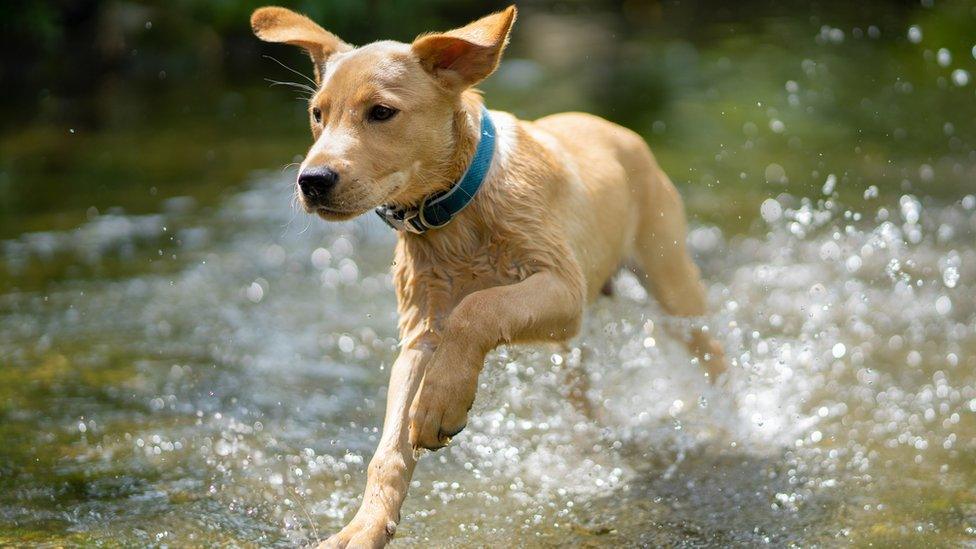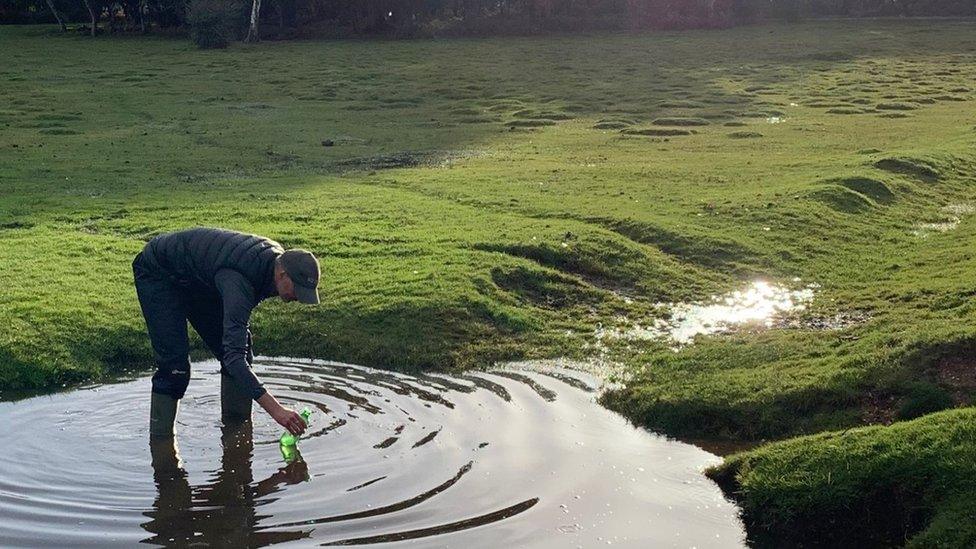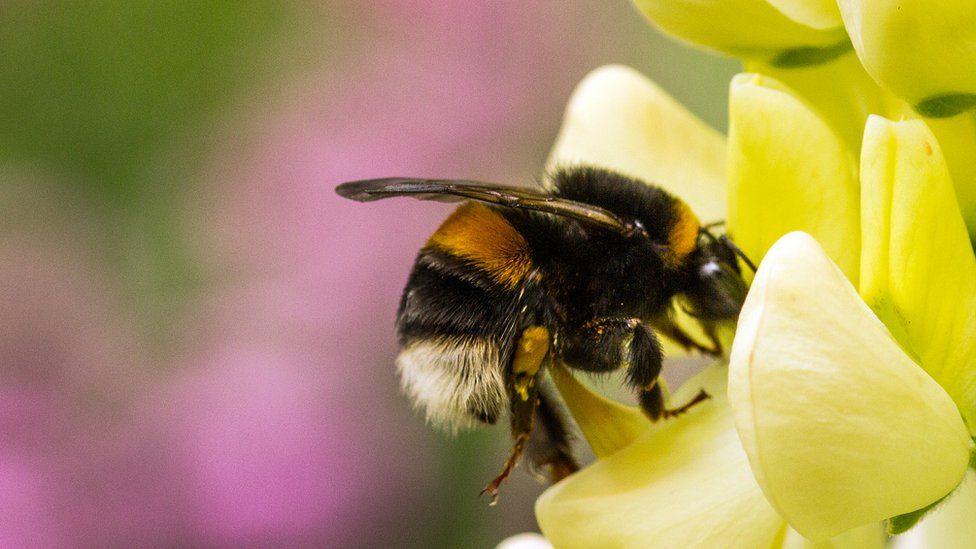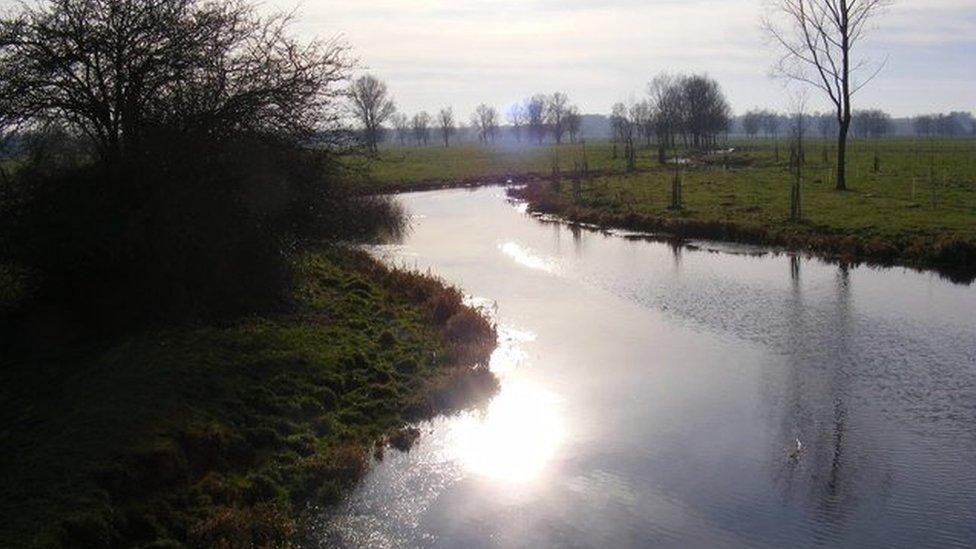New Forest warning over dog-flea chemicals in ponds
- Published

There is concern that anti-flea and tick treatments are washing into watercourses
Anti-flea and tick treatments for dogs could be harming sensitive streams and ponds in the New Forest, conservationists have warned.
A study by Wild New Forest and the Freshwater Habitats Trust showed high levels of imidacloprid, found in spot-on treatments, at four locations.
Previous research found it negatively affected insect species.
The New Forest Dog Owners Group (NFDOG) said owners should be made aware of less harmful alternative treatments.
The survey work was conducted in October at sites where dogs were known to enter the water to swim or splash.
Researchers said one of the sites, Dibden Bottom, had levels of imidacloprid at nearly double the internationally agreed toxicity threshold for aquatic invertebrates.
The samples collected from Cadmans Pool, Green Pond, and Janesmoor Pond also contained imidacloprid, with the values at Janesmoor Pond being just below the toxicity threshold.
Imidacloprid is a highly toxic pesticide that is banned for use in outdoor agriculture, but continues to be widely used in pet flea treatments, typically applied to the back of the pet's neck - known as spot-ons.
Conservationists have raised concerns about its detrimental effect on insect life including dragonflies, mayfly larvae and damselflies, which are important components of the aquatic ecosystem, providing food for fish, birds, and bats.

Water sampling was carried out at four locations in the New Forest
Dr Naomi Ewald of Freshwater Habitats Trust said: "These habitats also support our rarest freshwater species, which have disappeared from large swathes of the wider countryside.
"Keeping New Forest freshwaters clean and free from polluting agricultural nutrients and urban chemicals is a priority if these species are to survive and thrive."
Prof Russell Wynn of Wild New Forest said: "Although there is growing awareness of the pervasive nature of these chemicals in English rivers, we suspect that most dog-walkers will be unaware of the potential impacts of allowing their dog to enter the water here in the New Forest.
"We hope that by collecting and openly sharing these data we can raise awareness amongst the community and start a positive discussion about less harmful alternatives".
Nanogrammes per litre recorded in October 2023
19 ng/lRecorded at Dibden Bottom
6 ng/lRecorded at Janesmoor Pond
8-10 ng/l International safe toxicity thresholds for aquatic invertebrates
Vet Alex Crook, from the Pilgrims Vets clinic in Fordingbridge, said he was "alarmed" at the presence of imidacloprid in forest water courses.
He said dog owners were often unaware of advice over the use of treatments which was "hidden in small print".
"I urge people to keep their dogs out of water for the recommended time after application, depending on which product they use," he said.
"Or better still to use alternative products altogether, like tablets.
"For many years farmers have been doing their bit for the New Forest environment by avoiding the use of certain drugs in their livestock, and now we are asking dog owners to follow suit."
Heather Gould of NFDOG said the findings were "important".
She said: "It's essential that we protect our environment.
"It's also important though, that dog owners protect their pets. Vets are aware of the issue, and owners should discuss this before selecting which treatment to use."

Imidacloprid was found to be present in the water at Janesmoor Pond near Fritham
Research carried out by the University of Sussex in 2021 found that imidacloprid was found in 66% of UK freshwater samples, and another neonicotinoid, fipronil, was detected in 98% of samples.
Further research published earlier this month, external showed that the toxic pesticides used in the flea products were washed into household drains when pet owners wash their hands after treating their animals.
The National Office of Animal Health, which represents the veterinary pharmaceuticals industry, said parasite control products were "essential in helping pets live longer, healthier, and more active lives".
"Decades of evidence around the world demonstrates the safety of these products when used according to label directions," it said.
"The quantities used in pet parasiticides cannot explain levels of the compounds detected in some waterways. These compounds have multiple other uses."
The government's Veterinary Medicines Directorate said the University of Sussex findings would be studied within the cross-government Pharmaceuticals in the Environment Group.
"It is important to highlight that there are several evidence gaps remaining, including the need to improve understanding of the impacts that flea and tick treatments have on aquatic ecosystems, animal health and human health."
It said all veterinary medicines "undergo rigorous scientific assessment" prior to approval, including an environmental exposure assessment.
Wild New Forest said it would carry out further survey work during the summer when water levels were lower and there was more recreational activity in the national park.

Follow BBC South on Facebook, external, X, external, or Instagram, external. Send your story ideas to south.newsonline@bbc.co.uk or via WhatsApp on 0808 100 2240.
Related topics
- Published18 January 2024

- Published14 December 2017
